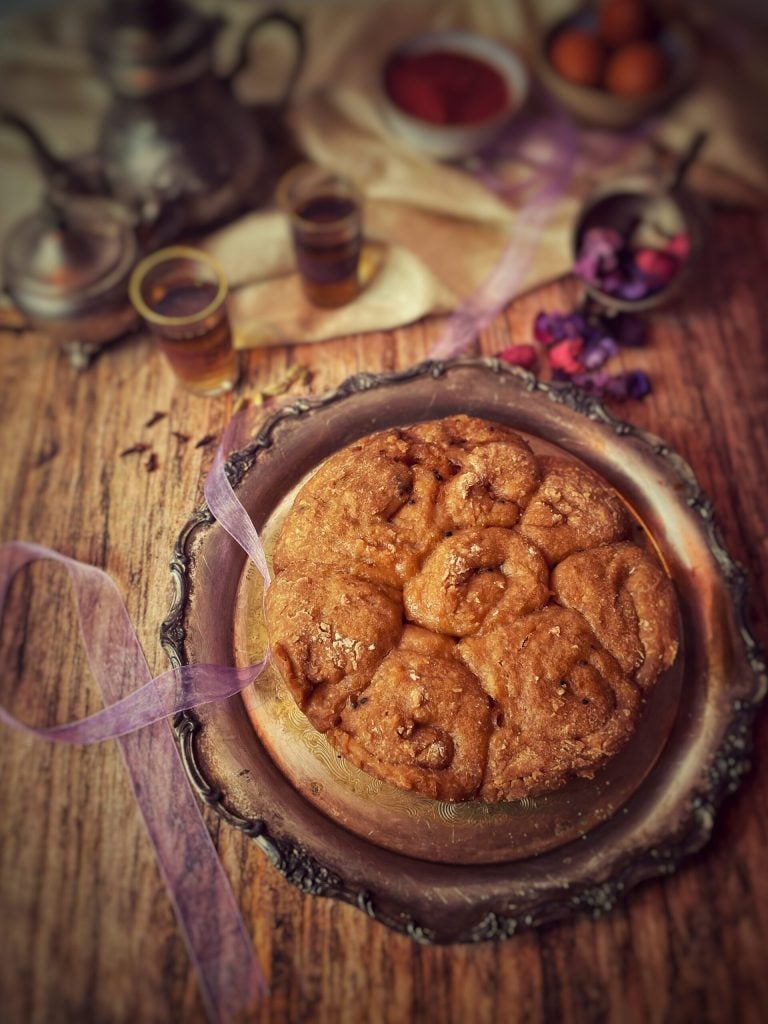Kubaneh, or Kabana or Kaban or Kubana, (in Arabic: كبانة ; in Hebrew: כֻּבַּאנֶה), is a yeasted bread baked in a pot greased with a tightly closed lid, where it cooks in its own steam.
Traditionally consumed by Yemeni Jews on Shabbat and holidays, the pot is usually placed in an oven (in the past a clay oven where it was placed over embers or dying coals) just before sunset, to remain until the next day, when the bread is eaten for the Shabbat meal or breakfast.
Similar to challah, Kubaneh is made with yeasted dough (formerly based on sorghum and corn flour on weekdays) rich in melted butter like samneh (sometimes substituted with margarine or oil), baked for 8-12 hours in a slow oven pot – at a temperature below 212°F.
In Yemen, it is eaten every day of the week and is specially prepared for Shabbat (among Jews of Sana’a and Northern Yemen), while in the Land of Israel it is eaten during the Shabbat morning meal.
There are different types of kubaneh:
• With the dough, it is soft, airy, and worked with a lot of oil or butter. Many add sugar or honey. This is consumed with a milk-based meal and sometimes seasoned with fenugreek seeds, alone or with chopped tomato, sahug, poached egg, samanah.
• Classic version (the following recipe): the dough is firmer with less oil and has a rather neutral taste, it is customary to eat it even when grandparents have a meaty and festive meal.
During the winter months, some had the habit of adding a piece of fatty sheep tail to the pot along with the Kubaneh, in that case, the bread became a meat dish.
It should be served hot with ghee, usually also with resek agvaniyot a kind of uncooked tomato sauce, or with haminados, like sabich, zhog (spicy sauce) or chili chutney.
• Israeli Kubaneh: unlike the previous ones, it is baked in a baking dish, once open, in the oven. Therefore, it has a completely different taste, reminiscent of a classic bun.

- Difficulty: Medium
- Cost: Economical
- Rest time: 40 Minutes
- Preparation time: 20 Minutes
- Portions: 6 People
- Cooking methods: Oven
- Cuisine: Jewish
- Seasonality: All seasons
Ingredients
- 21 oz flour
- 3 teaspoons sugar
- 5 oz samneh (or butter)
- 8 g dry yeast
- 20 g salt
- 2 cups lukewarm water
- to taste nigella
Tools
- 1 Pot Dutch oven type
Steps
Mix the flour with the sugar, add the melted butter, salt, yeast dissolved in a little lukewarm water, and water.
Knead the dough, let it rest for 10 minutes, and then knead it again.
Repeat for 4 times.
Grease the pan.
Divide the dough into 8/10 pieces. Roll them out, fold the edges, sprinkle with nigella, and roll it up like a ‘little rose.’
Place each ‘rose’ next to each other in the pot. Cover and cook for 3 hours at 212°F.
Flip the bread, then put it back in the pot. Cover and cook at 199°F for another 3 hours or at 212°F for another hour and a half.

Curiosities
Once during the Shabbat morning prayer, some were used to leaving the prayer to eat kubaneh. However, this practice eventually sparked controversy among rabbis.
FAQ (Frequently Asked Questions)
What is samneh?
Samneh is a refined butter used in Yemeni cuisine in particular and in Arab cuisine in general.
During the refining process, the milk solids are removed from the butter (milk proteins and sugars), which extends its shelf life and also makes it an allergen-free food additive.
It is prepared in two stages. In the first, the butter is melted in a saucepan, and the top layer of foam that forms during cooking is removed.
In the second stage, after the foam has completely disappeared, the contents are filtered into a jar and sealed tightly.
Sometimes toasted fenugreek seeds are added for flavor.
In the region of Eden, there was another version that involved adding green onions to the butter.

